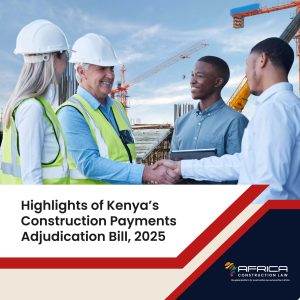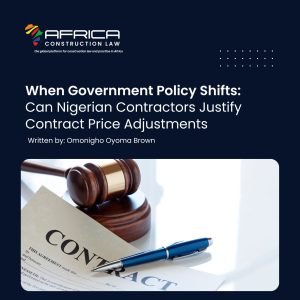Author: Toheeb O. Amuda, Esq., LL.M
- Introduction
Construction contracts, by their nature, involve complex and detailed provisions to address various contingencies and disputes that may arise during the course of a project. The FIDIC suite of construction contracts are widely used in international and domestic construction projects and are known for their comprehensive structure. The contracts are written and published by the International Federation of Consulting Engineers. The FIDIC acronym stands for the French version of the Federation’s name – Fédération Internationale des Ingénieurs-Conseils.
Despite the detailed nature of FIDIC contracts, conflicting dispute resolution clauses can still pose significant challenges, particularly in cases involving multiple contracts and various amendments and supplements. This article explores the implications of such conflicts in construction contracts, drawing on the author’s practical and personal experience, and provides guidance on navigating these issues.
- FIDIC Contracts and Dispute Resolution
FIDIC contracts are a suite of standardized construction contracts used globally, designed to allocate risks fairly between parties. The FIDIC suite includes the Red Book (for building and engineering works designed by the employer), the Yellow Book (for plant and design-build contracts), the Silver Book (for EPC/turnkey projects), and others. Each of these contracts contains detailed provisions for dispute resolution.
Typically, FIDIC contracts include a multi-tiered dispute resolution mechanism comprising
- Dispute Avoidance/Adjudication Board (DAAB): An impartial body set up at the project’s inception to provide informal advice and formal decisions on disputes.
- Amicable Settlement: If a party is dissatisfied with the DAAB’s decision, they can seek to resolve the dispute amicably.
- Arbitration: If amicable settlement fails, the dispute can be referred to arbitration, often under the rules of institutions like the International Chamber of Commerce (ICC).
- Conflicting Dispute Resolution Clauses
Conflicting dispute resolution clauses arise when different parts of a contract or different contracts within the same project stipulate different methods or forums for resolving disputes. This can lead to confusion and inefficiency, undermining the objective of swift and fair dispute resolution.
- Sources of Conflict
- Multiple Contracts: Large construction projects often involve multiple contracts with different parties. For instance, a FIDIC Red Book contract with the main contractor and bespoke contracts with subcontractors might have different dispute resolution clauses.
- Amendments and Supplements: Modifications to standard FIDIC terms can introduce inconsistencies. For example, an employer might amend the FIDIC clauses to align with local legal requirements, inadvertently creating conflicts.
- Hierarchical Inconsistencies: In some projects, there are different hierarchical levels of contracts, such as a main contract and several subcontracts, each with its own dispute resolution clause.
- Conflicting Clauses in the Same Contract: Conflicts within a single contract can occur when the main or principal contract contains a dispute resolution clause that differs from those in the Particular Conditions of Contract or the General Conditions of Contract contained in the adopted FIDIC contract. Such inconsistencies can lead to confusion and delays in the resolution process. For instance, in a practical example where this author provided advisory services that resolved such conflict, an Engineering, Procurement and Construction (EPC) contract for a Gas Processing Plant incorporated the FIDIC Contract for EPC/Turnkey Projects (the Silver Book). In this case, the Principal Contract document stipulated that arbitration should be initiated after 30 days of failing to resolve the dispute amicably. Conversely, a sub-clause of the Particular Conditions of Contract specified that arbitration should commence after 56 days of unsuccessful amicable resolution efforts. This discrepancy in the dispute resolution clauses, specifically, the differing timelines for initiating arbitration, led to several rounds of correspondence and significant project delays. The parties involved were also unable to agree on a sole arbitrator due to the conflicting timeframes, exacerbating the delay and complicating the dispute resolution process. A key piece of advice provided to the parties in that dispute was the critical role of the priority of documents clause in FIDIC contracts. This clause gives priority in the hierarchy of construction documents to the Principal or Main Contract document. This guidance led the parties to settle on the dispute resolution clause contained in the Principal Contract document, ultimately resolving the conflict and clarifying the dispute resolution process. The concept of priority of documents in construction contracts is further explained below.
- Mitigating Conflicts in Dispute Resolution Clauses
Conflicting clauses can lead to jurisdictional disputes and delays in dispute resolution. Courts and arbitral tribunals generally seek to interpret conflicting clauses in a way that gives effect to the parties’ overall intentions. For instance, in Sulamérica Cia Nacional de Seguros SA v Enesa Engenharia SA [2012] EWCA Civ 638, the English Court of Appeal emphasized the importance of a “one-stop” dispute resolution mechanism and sought to reconcile conflicting arbitration and litigation clauses in favor of arbitration. However, reliance on judicial interpretation can lead to unpredictability. Hence, clear drafting and consistent dispute resolution clauses are essential.
In the context of FIDIC contracts, particularly when multiple contract documents are involved or when a single contract contains differing dispute resolution clauses, it is interesting to note that FIDIC contracts contain a priority of documents section. This section establishes that in the event of conflict or discrepancy, the main Contract Agreement (if any) takes precedence, followed by the Particular Conditions, the General Conditions and then other documents such as the Employer’s Requirements, Schedules, the Tender documents and other documents forming part of the Contract.
To mitigate the risk of conflicting dispute resolution clauses, parties should:
- Ensure Consistency in Drafting: Ensure that all contracts within a project have consistent dispute resolution clauses. This may involve standardizing clauses across different contracts and ensuring alignment with the primary contract. Such alignment includes providing for the same forum, governing law, and rules in their dispute resolution clauses. This uniformity (a) streamlines the dispute resolution process, reducing complexity and avoiding the need for different procedures for different contracts (b) avoids the risk of conflicting decisions under different governing laws such as in civil and common law countries, in cases of parallel litigation or arbitration (c) avoids the expense of navigating multiple legal systems and hiring different legal experts for different jurisdictions.
- Integrated Contract Management: Use integrated contract management systems to oversee and harmonize all contracts related to a project. One example of such integrated contract management system is Aconex, a platform widely used in the construction and engineering industries. Aconex facilitates document management, project communication, and workflow automation, allowing all project stakeholders to access and manage contracts and related documents in a centralized and organized manner. In a FIDIC project, all contract documents, including the Principal Contract, Particular Conditions, and General Conditions, can be stored and accessed through Aconex. It allows for real-time collaboration, automates workflows for contract approvals and tracks contract amendments and supplements.
- Clear Hierarchical Clauses: Clearly define the hierarchy of contracts and specify which contract’s dispute resolution clause prevails in case of conflict.
- Legal Review: Engage legal experts to review all contract documents to identify and resolve potential conflicts before contract execution.
- Conclusion
Conflicting dispute resolution clauses in construction contracts, particularly those involving FIDIC terms, can lead to significant legal and practical challenges. Ensuring consistency, clarity, and careful drafting can mitigate these risks and promote efficient dispute resolution. As construction projects continue to grow in complexity, the importance of robust and harmonized dispute resolution mechanisms cannot be overstated.
14 July 2024


















